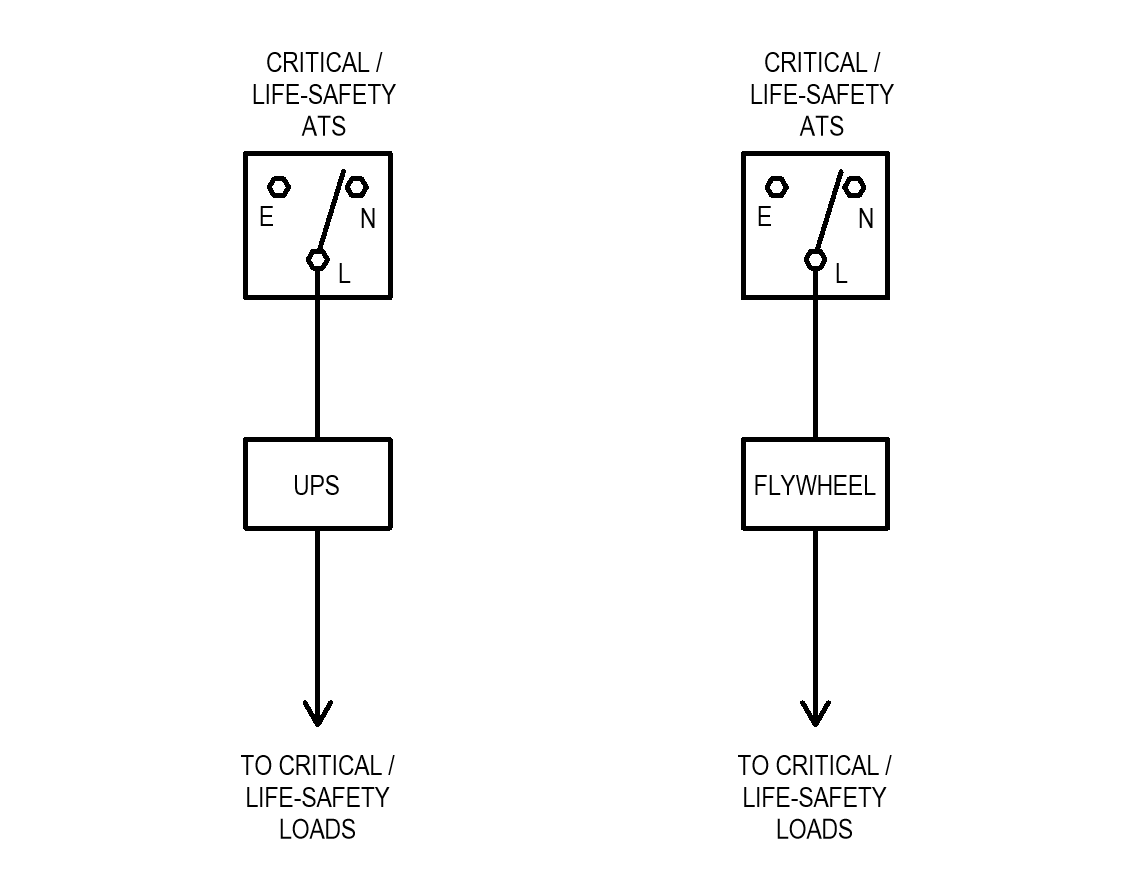The Evolving Importance of Health Care Resiliency
Maintainability and Safety
The design of power systems has a significant impact on the ability of the facilities’ staff to perform routine maintenance on the equipment. Staff safety is also of critical importance. There are several strategies that can be employed to improve both the maintainability and safety of power systems.
Redundant Normal Feeds to Critical and Life Safety Transfer Switches
In critical facilities, where downtime of electrical systems can significantly impact business operations, the normal feed to automatic transfer switches (ATSs) can be connected to two feeder breakers that are bussed together. In this scenario, one breaker would be closed to supply normal power to the ATSs, and the second breaker would be open. Routine maintenance can be completed on the open breaker, and then it can be closed to momentarily parallel with the other breaker, which will then be opened. The ATSs will not experience an outage and, now, routine maintenance can be performed on the second normal feeder breaker. This configuration allows for seamless operation while providing maintenance flexibility without having to run an emergency generator every time maintenance occurs.
Stored Energy Systems for Critical and Life Safety Loads
Stored energy devices, such as uninterruptable power supply (UPS) and flywheel systems, are often used as a short duration power source (up to five minutes) that is sufficient to allow emergency generators to start and transfer loads (usually within 10 seconds). In hospitals, one common application is to install a UPS on the load side of critical transfer switches. This protects those loads from power interruption during short duration outages or regularly scheduled during generator testing.

Image courtesy of SmithGroup
FIGURE 10. A one-line diagram of stored energy systems for critical and life safety loads.
ATS with Bypass Isolation for Critical and Life Safety Loads
It is considered good engineering practice to install ATSs with bypass isolation for critical and life safety power branches. Since the ATS is often a single point of failure in the power system, the ability to maintain those switches is critically important. Transfer switches with bypass isolation allow facilities staff to perform maintenance on the transfer switch by placing it in bypass without interrupting the downstream loads.
Arc Flash Maintenance Mode – ARMS and ZSI
Arc flash is considered one of the most dangerous hazards for maintenance personnel. Arc flash reduction maintenance switches (ARMS) and zone selective interlocking (ZSI) are two of the most common forms of protection when working on energized electrical equipment. ARMS is turned on by staff. Once turned on, all instantaneous settings of protective devices are reduced to clear any fault quickly rather than selectively. ZSI is a communication method between upstream and downstream electronic trip circuit breakers that allows circuit breakers to trip instantaneously on a fault in its zone without sacrificing selective coordination of electrical systems. ZSI is considered to be a more advanced arc flash reduction technology, since it does not require any actions on behalf of the facilities staff compared to ARMS that needs to be turned on and off every time to perform maintenance on energized equipment.
Remote Control to Operate Breakers
With advancements in technology for building power distribution systems, major electrical equipment manufacturers have introduced circuit breakers that can be operated by mobile applications that connect to circuit breakers via Bluetooth technology. A benefit of using remote operable circuit breakers is the safety of personnel who do not need to be in front of a breaker to operate it.
Circuit Breakers with Metering Capability
Electrical distribution systems in critical facilities often must be designed to be adaptable to facility upgrades and program changes. When designing upgrades to an existing power system, accurate trend data about electrical loads is important for the design engineer. Capturing meter data is also useful for troubleshooting when a problem occurs. Electronic trip units on breakers typically have built-in metering capabilities, but without a software system to capture and trend the data, the full benefit of the metering is not being realized. The software solution is often overlooked or removed during value engineering. Manufacturer software for data collection and analysis will show trends in energy usage and provide data for engineers to use to size new equipment and also troubleshoot existing problems in the power system.
Conclusion
When designing power systems for critical facilities, it’s extremely important to consider resiliency, reliability, maintainability, and staff safety. Without proper design considerations for these factors, there is a risk of significant facility downtime, which is often very costly in terms of lost revenue or interruption of business continuity. This article described just a few of the approaches available to improve resiliency, reliability, and maintainability. Design engineers should consider and utilize methods based on project specific requirements and needs.
Subhead References
- NFPA 70 National Electrical Code, 2017
- NFPA 99 Health Care Facilities Code, 2018
- FEMA P-1019 Emergency Power Systems for Critical Facilities, 2014

|
Keith Garratt, P.E., LEED AP, is a principal at SmithGroup. He boasts more than 20 years of professional experience and specializes in academic medicine, acute care, ambulatory care, cancer care, MEP building systems, and more. |

|
Aleksei Isingaziev, P.E., is an electrical engineer at SmithGroup. He has more than eight years of professional experience and specializes in health care and commercial facilities infrastructure engineering. |



